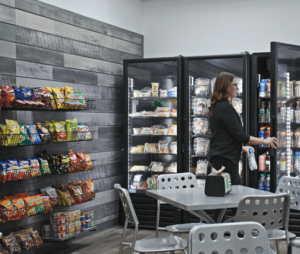
A recent Foodservice IP blog covered the return to the office and how sandwiches could present an opportunity for operators seeking to turn hungry workers into customers. Sandwiches appeal to office workers while delivering higher ticket totals to operators.
In addition to emphasizing portable, customizable options (i.e., with sandwiches), foodservice firms should consider how to increase convenience. Given that convenience is the most important factor in a worker’s lunch choice, easily accessible operators will have a critical edge over the competition. One way foodservice manufacturers and operators can pursue convenience is micromarkets—unattended retail spaces where consumers use vending machines or self-checkout stations to purchase food and beverages.
According to our research, micromarkets have experienced 18% growth since 2021. There are many factors driving this rise. The COVID pandemic and 2020 saw an increase in contactless payments and labor shortages—both of which seem here to stay. Micromarkets allow operators to deliver the variety of a convenience store, but with the labor footprint of a vending machine business.
If manufacturers and operators are interested in micromarkets, there are a few things they should keep in mind:
Higher Profit Margins…
FoodserviceIP’s research found that micromarkets have higher profit margins than traditional vending. Sixty percent of respondents reported a profit margin over 20%, including 4% of respondents with margins over 40%. This is because the markets have a labor-saving design, but consumers are willing to pay a higher price point at these venues. Lower costs and higher revenues lead to higher margins.
…If You Deliver Value
If consumers are willing to pay more, it is because they see value. In the case of micromarkets, that value comes in three forms: convenience, variety, and quality. In our research, we found that consumers were most likely to purchase from micromarkets in their workplace or school. The physical proximity and expanded service hours make these venues very appealing.
Ease, however, can only take these markets so far. They must also deliver variety and quality. Micromarkets differentiate themselves from vending machines with fresh offerings (e.g., salads, fruits and vegetables). This means that while labor costs will be lower than a traditional convenience store, they will be higher than conventional vending. Some products will need to be prepared at an off-site ghost kitchen, and other items will need daily restocking. These quality and variety challenges mean that foodservice operations with existing food preparation and delivery processes may more easily move into this sector than vending operators.
The Bottom Line
As workers seek convenient food options and operators continue to deal with changing consumer preferences, labor conditions, and payment practices, micromarkets are poised to expand. Manufacturers and operators who can maximize value to the end consumer (through convenience, variety, and quality) could be well-positioned to capture unusually high profit margins.
This article shares a few insights from Foodservice IP’s recent micromarket study.
Foodservice IP is a professional services firm based in Chicago, aimed at delivering ideas for managers to guide informed business decisions. To learn more about FSIP’s Management Consulting Practice, click here.
Like the content? Sign up to receive our communications.
Recent Comments